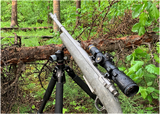Part 4-Inletting the Gunstock A .404 Jeffery Stalking Rifle
Scrutinizing the Gunstock The stock duplicated from my blank using my pattern arrived in early April. The blank had a flaw on the right side of the butt section that penetrated about 3/16" that was avoided, as expected, with good machine set up. When evaluating a gunstock blank the two most important considerations for me are grain and figure. Regardless the firearm being stocked, the grain is the most important of these two needs.
I think the grain integrity of the grip needs to extend rearward well into the butt and forward through the forearm to provide the strength needed to minimize breakage possibilities. You can imagine the basis of a good gunstock by visualizing a long 2" diameter straight-grained dowel that is centered through the grip, running the length fore and aft through the entire gunstock. The rest of the stock is just wood cast in supporting roles that contributes little to the overall strength of this core.
Regarding evaluation of the figure visible in the blank it is not unlike looking at a pretty overdressed woman and trying to visualize what lies below. The blank's figure merely teases and hints at the gunstock's possibilities.
The grain was relatively easy to evaluate with my blank and I had traced my desired location of the final gunstock on it with a wide marker. The figure that would emerge from this layout was left to chance. The pattern had the Henry fore end tip shaped and colored with marker for the duplicator operator's reference. The pattern butt stock had been left 1/2" long for wiggle room when I created the final dimensions.
What I got back is a gunstock that I am quite happy with. The entire forearm is straight-grained, the grain running parallel to the barrel channel. The grain through the wrist connects nicely with the action section and carries through the butt. The core is solid and continuous from stem to stern. It was apparent that I had more wood both inside and outside than I expected from the duplication but that is a solvable problem.
Getting Started My small austere 'shop' is marginal for the kinds of work I perform here. A top-mounted swivel bench vise with rubber jaws and a 10" side-mounted woodworking vise were used to hold the gunstock as I worked on it. The action screw holes in the gunstock were precisely 1/4" and my guide screws made to use on the pattern would again be employed. I was ready to get started but had to plan out one of the gunstock fixtures.
I had a piece of Asian buffalo horn for the fore end tip which at some point would have to get installed. The Ruger No. 1 that I completed last year also had a horn tip but I had attached that using two 1/4" dowels of 1018 steel that had been scored on the lathe. I wanted to use a larger diameter wood dowel and was looking for a better solution.
A 15mm Forstner bit used in a cabinet making project last summer was used to experiment with drilling holes in horn end grain. I was quite surprised to see paper thin white sheets of waste emerge when drilling like that. The resulting hole was clean and smooth. I put the horn tip in the mill vise and using an end mill squared the face in my bench mill. I then chucked up the bit and drilled a hole about 1" deep in my tip blank. I had no way to turn an integral dowel on the fore end of my gunstock so I squared it at the correct location with a miter saw intending to drill a hole later. The tip would be affixed as the inletting progressed.
Finishing the Job The final stages of the inletting process described in Part 3 were repeated to bring the bottom metal to full depth and then the stock was turned and inletting of the the barreled action proceeded. A small amount of gouge work was needed to widen and deepen the barrel and action channel but scraping accounted for most of the time spent on this chore.
When I was about 3/16" from my final depth for the barreled action, I located the center of the squared fore end for attaching the tip and using a hand drill and the Forstner bit drilled a hole about 1 1/2" deep into the gunstock. While the resulting hole was less precise than the hole drilled earlier in the horn tip with the mill, it was totally satisfactory. A 3" long dowel was turned from a dense piece of thin shelled walnut and I was now ready to glue it in place.
I had some Black Max cyanoacrylate in the refrigerator that I intended to use on the fore end tip. Unfortunately, past its shelf life, it had turned into a thick and unusable mass. After thoroughly cleaning the dowel, the horn tip and hole in the gunstock with acetone I used the cyano glue I had on the bench to glue the parts together. Moderate holding pressure was applied with a long woodworking clamp and this all was left to set up overnight.
Scrapers are an effective and efficiency way to remove horn waste and the barrel channel was extended through the horn tip from the stock barrel channel. Inletting was then finished with careful scrapping to full depth and the action screws were timed short about 1/8 revolution.
I had proud surfaces that now needed to be brought to near metal surface level. A few paper thicknesses would be adequate to allow the final finish application to bring them even.
Next-Part 5 Final Shaping of the Stock




